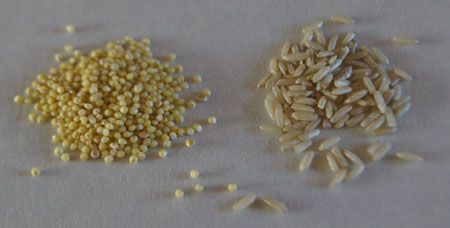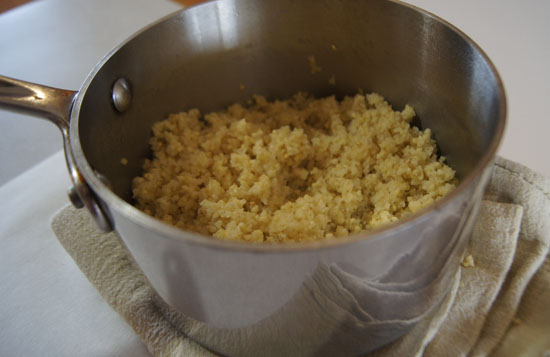“Which grain was first farmed nearly 10,000 years ago? Which grain was revered as one of five sacred crops in ancient China? Which grain is mentioned in the Old Testament, the writings of Herodotus, and the journals of Marco Polo? The answer is millet!”
Thus reads the package of Bob’s Red Mill whole grain hulled millet that I hold in my hands. The millet is small and round and sort of yellow-tan in color. I want to learn more about this ancient grain!
Millet is the generic name for a group of small-seeded grasses. The most prominent types of millet are finger, pearl, foxtail, proso, and little millet. One less popular type called great millet is actually sorghum bicolor. White and black fonios are related to millet, as I learned while writing my post on fonio. Millet grows well in hot and dry climates and has a short growing season. According to Wikipedia, 97% of the world’s millet is produced in developing countries in Asia and Africa. Millet is “whole” because it includes the bran, germ, and endosperm. It is also gluten free.
The Experience Life website states “Like quinoa and amaranth, millet is actually a seed, but it’s classified as a grain in cookbooks because that’s the way it’s most often prepared.”
Millet was a “Grain of the Month” on the Oldways Whole Grain Council website. It’s thought that before rice, millet was the staple grain in Asia. Today, in India, millet is used to make the flat bread roti, a staple flat bread. In Africa, millet is generally cooked as a porridge. And, it is used to make beer.
I continue to prowl the web for information on millet, and stumble on this book: Whole Grains Every Day, Every Way, by Lorna Sass. Wow! Lorna Sass covers all of the grains I have covered in this blog. I decide I must have this book – so I order it. And I have so much to say about it, that I will have to make my comments a separate blog post. (I bought the Kindle version, so I can immediately read what Lorna Sass knows about millet.)
I learn from Whole Grains Every Day, Every Way that In the US, proso is the most common millet. And what is it used for here? Birdseed! Health food stores began selling millet for people, and then gluten-free diets increased its popularity. Now millet is pretty easy to find in many types of markets, as well as online.
Bob’s Red Mill has a good blog entry that is a comparison of four grains: millet, quinoa, barley, and amaranth. I also like an entry The World’s Healthiest Foods: “Although millet is most often associated as the main ingredient in bird seed, it is not just ‘for the birds.’ Creamy like mashed potatoes or fluffy like rice, millet is a delicious grain that can accompany many types of food. As with most grains, millet is available in markets throughout the year.” An Encyclopedia Britannica article has wonderful photos and also illustrations that show how grains are milled.
I did find one caution about consumption of large amounts of millet. Some types of millet contain goitrogens. What are these? They are substances that suppress thyroid activity and can lead to goiters, or enlargement of the thyroid gland. (Reference: The Healthy Home Economist.) Why It Matters What Type of Millet You Eat is a fun to read article by Chris Masterjohn, PhD. He explains that proso millet is okay – and from what he found out from Bob’s Red Mill and what I found out from Lorna Sass, proso millet is the type of millet we are most likely to obtain in the United States.
Bob’s Red Mill millet, probably proso millet:
 Millet compared to medium grain brown rice:
Millet compared to medium grain brown rice:

Nutrition
1/4 cup of dry millet (55 grams) has 210 calories, 3 grams fiber, 5 grams protein, 8% iron, 12% niacin, 8% vitamin B6, 8% folate, 8% riboflavin, 14% thiamin, 40% manganese, 14% phosphorus, 4% zinc, and 15% magnesium.
The glycemic index values for millet range from 45 to 71, depending on the type of millet and how much the grain is processed.
The World’s Healthiest Foods discusses other health benefits of millet.
Cooking
| water | time simmering | |
| 1 cup millet | 2 cups | 20 minutes |
The above instructions are from the Bob’s Red Mill package. Lorna Sass, in her book “Whole Grains Every Day, Every Way”, recommends three ways to cook millet:
Fluffy: Toast 1 cup millet for 4-6 minutes in a dry pan over medium heat, until it begins popping and emits a toasty aroma. Off heat, carefully add 2 ¼ cups boiling water, 1/4 teaspoon salt, and 1/2 tablespoon butter. Cover and simmer 13-18 minutes until most of the water is absorbed, then let stand 10 minutes. Fluff up before serving. Use like you would rice.
Sticky: Don’t toast the millet. Put 1 cup millet in a pan with 2 ¾ cups water and 1/4 teaspoon salt, simmer for 13-18 minutes, then let stand 10 minutes. Sticky millet can be molded in croquettes and patties or pressed into a pan.
Creamy: Start with millet “grits”, or make your own by grinding 1 cup millet in a spice grinder, 1/2 cup at a time, into a coarse meal. Bring 5 cups water (with 1/4 teaspoon salt) to a boil, then gradually whisk in the ground millet. Cover, lower heat and simmer, stirring occasionally for 15 to 30 minutes until grits are tender (the length of time depends in the size of the grits and the altitude). Creamy millet is good as a breakfast porridge, or it can be used like polenta.
I cooked millet according to Sass’s “fluffy” directions. I had it simmering gently: each time I peeked, it was obviously at a boil, but the lid wasn’t bumping like crazy. At my altitude of 5300 feet, it took 23 minutes for all the water to be absorbed. After a few minutes left standing off heat, it fluffed up nicely with a fork:
 I think it is beautiful! It tastes a tiny bit like corn, and not all the seeds cooked evenly, giving it just about the perfect amount of crunch. (“Crunch” is an important factor in my food tasting!)
I think it is beautiful! It tastes a tiny bit like corn, and not all the seeds cooked evenly, giving it just about the perfect amount of crunch. (“Crunch” is an important factor in my food tasting!)
Recipes
Millet can be used like rice, as a porridge, like mashed potatoes, and in many other dishes. It kind of depends on how you cook it. The “fluffy” way would work great under a spicy sauce or in a tabouleh style salad. The flavor is pleasant and not dominating. Actually, I think it would be great with some Mexican flavors, and served along with beans as a side for enchiladas and the like.
Here are examples of recipes from “Whole Grains Every Day, Every Way”.
- Millet Pie with Spinach and Feta
- Millet with Buttermilk and Chives
- Millet with Gingered Beets and Orange
Oldways Whole Grain Council site
- Millet-Cauliflower “Mashed Potatoes”
- Curried Sweet Potato and Millet Soup
- Sesame-Millet Crackers
- Millet Apple Raisin Cake
Food Network
